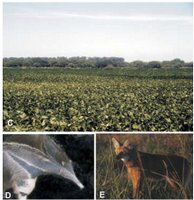 Toxic Algae Prompts Warnings: Blooming Green Sludge
Toxic Algae Prompts Warnings: Blooming Green Sludge
Causes Health Concerns in Klamath Reservoirs
Sacramento Bee (posted by sacbee.com)
15 Aug 2006
Matt Weiser
Photo and Map courtesy of Sacramento Bee
A record bloom of toxic algae in Klamath River reservoirs prompted health warnings Monday from state and federal officials. Concentrations of the algae Microcystis aeruginosa are so great that even breathing vapors caused by water skiing could cause illness, officials said, and swallowing even a few ounces of lake water could bring effects as severe as organ failure. The algae is not a new problem on the Klamath. But the highly toxic concentrations now present are yet another bruise for a troubled river that also triggered a commercial salmon fishing disaster this year. The bright green algae is so thick that parts of Irongate and Copco reservoirs on the Klamath look like radioactive putting greens.
The algae is not a new problem on the Klamath. But the highly toxic concentrations now present are yet another bruise for a troubled river that also triggered a commercial salmon fishing disaster this year. The bright green algae is so thick that parts of Irongate and Copco reservoirs on the Klamath look like radioactive putting greens.
"It's no longer just a matter of fish. It's now a human health issue," said Zeke Grader, director of the Pacific Coast Federation of Fishermen's Associations. The algae itself is usually not toxic and is common, at low levels, in many water bodies. But in warm, stagnant water it often blooms in huge floating mats, releasing a toxin, called microcystin, that can cause illness.
Bioterrorism Focus of New Surveillance
The Free Lance-Star (posted by fredericksburg.com)
15 Aug 2006
Rob Hedelt
Not long ago, there were short reports in this newspaper and others about The Wildlife Center of Virginia being chosen to develop a surveillance network designed to detect possible bioterrorism across the U.S. It didn't surprise me that the project would go to the Wildlife Center, perhaps the most well-known and advanced center of its kind in the country.
I wanted to know more about this system they would be researching and developing. Would it be for detecting anthrax in deer? Cholera in pigs? The plague in songbirds? To find out more, I dropped in on Wildlife Center Director Ed Clark and Patti Bright, the center's director of veterinary medicine.
They were glad to share basic details of the $166,000, six-month contract with the Institute for Defense and Homeland Security, a consortium of university, industry and federal research and development partners. Funding for it and other projects came through a research division of the Air Force. Clark and Bright explained that the idea behind the project, called Project Tripwire, is simple.
Trade: Illegal Trade in Wildlife
BizChina (posted by ChinaDaily.com)
15 Aug 2006
Speakers at an international conference on wildlife trade crimes held in Beijing in July claimed that illegal trade in wild animals and plants has topped 10 billion US dollars, and is the world third largest source of illegal trade after drugs and guns.
Cao Qingyao, a spokesman for the State Forestry Administration, said on Tuesday that China is stepping up protection of endangered wildlife resources. He told a press conference that a new regulation concerning the import and export of endangered wildlife would come into effect September 1.
The regulation bans the import and export of endangered wild animals and plants and related products for commercial purposes. It also forbids exports of unnamed and newly discovered wild animals and plants.
Biodiversity Loss Threatens Human Well-Being [Journal Article]
PLoS Biology
15 Aug 2006
Sandra Díaz, Joseph Fargione, F. Stuart Chapin, David Tilman
Photos Courtesy of Sandra Diaz and Marcelo R. Zak
 The diversity of life on Earth is dramatically affected by human alterations of ecosystems. Compelling evidence now shows that the reverse is also true: biodiversity in the broad sense affects the properties of ecosystems and, therefore, the benefits that humans obtain from them.
The diversity of life on Earth is dramatically affected by human alterations of ecosystems. Compelling evidence now shows that the reverse is also true: biodiversity in the broad sense affects the properties of ecosystems and, therefore, the benefits that humans obtain from them.In this article, we provide a synthesis of the most crucial messages emerging from the latest scientific literature and international assessments of the role of biodiversity in ecosystem services and human well-being.
Human societies have been built on biodiversity. Many activities indispensable for human subsistence lead to biodiversity loss, and this trend is likely to continue in the future. We clearly benefit from the diversity of organisms that we have learned to use for medicines, food, fibers, and other renewable resources.
Northeastern Transportation and Wildlife Conference [Conference Announcement]
Maine Department of Transportation
15 August 2006
The Northeastern Transportation and Wildlife conference is a regional outgrowth of ICOET, International Conference on Ecology and Transportation. This is a forum on issues relating to interactions a between wildlife and transportation systems and associated impacts.
This conference will allow states to share their work since the 2004 conference, discuss what they plan for the next 2 years, and give an update on the state’s Statewide Wildlife Conservation Plans.
Information will also be shared on current strategies being used to reduce the impacts of transportation facilities on terrestrial, aquatic and fishery resources. An exposition of Vendors is also planned.





No comments:
Post a Comment